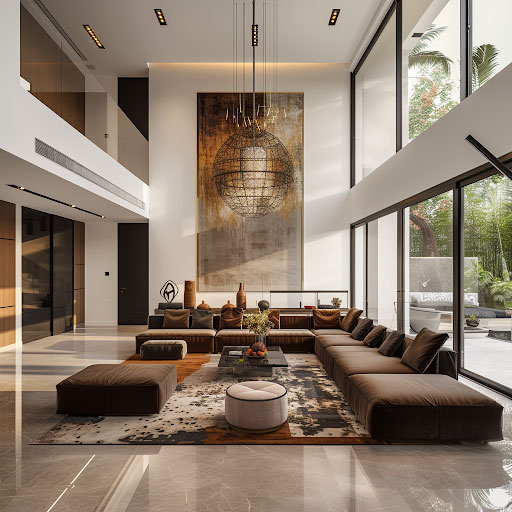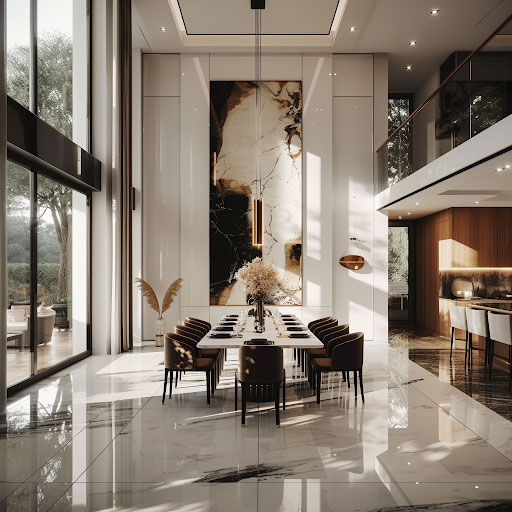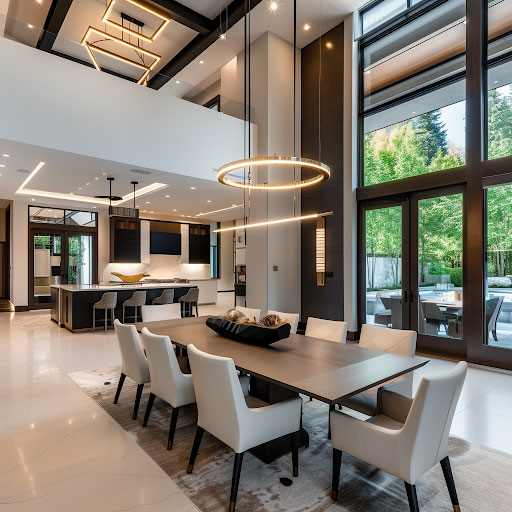The role of a custom home builder in crafting your dream home extends beyond construction; it involves guiding you through the exhilarating process of design personalization while keeping a vigilant eye on budget constraints. A skilled custom home builder not only facilitates the realization of your vision without compromising on quality but also navigates the financial intricacies to ensure your project remains within budget. So, how do you maximize the value of your custom home without stretching your finances?
1. Maximizing Efficiency in Design
Establishing a collaborative design process is the cornerstone of an economically efficient custom home. Engaging with seasoned architects and designers from the outset is not just about ensuring the home mirrors your vision; it’s about adhering to budget constraints without sacrificing that vision.
These experts are pivotal in steering the design phase towards cost-effectiveness, leveraging their experience to make informed decisions that balance your desires with practical budget realities. This collaborative approach fosters a dynamic where your dream and budget align, paving the way for a design that’s both aspirational and attainable.
Practical and Aesthetic Balancing
Achieving a seamless blend of aesthetics and functionality is pivotal in custom home design. It’s about creating spaces that not only captivate with their beauty but also serve practical needs efficiently while navigating space and budget constraints. This balanced approach is vital to designing beautiful and livable homes, reflecting the unique preferences and lifestyles of their inhabitants.
Living Area/Home Office Combo
Incorporate built-in shelving that serves as a display for decorative items and as storage for work materials. A desk that doubles as a dining table can offer a practical yet stylish solution, embodying the dual essence of work and leisure in one space.
Convertible Home Gym
Utilize a fold-away wall unit to store exercise equipment in a guest room, enabling the room to maintain its welcoming purpose while offering a private fitness area. Mirrors and strategic lighting can enhance the dual functionality, creating an inviting and utilitarian space.
Kitchen with Integrated Dining
Design a kitchen island that serves as both a cooking space and a casual dining area. Opt for durable materials for kitchen use yet elegant enough to complement dining aesthetics, ensuring the island is a centerpiece that meets various needs.
Outdoor Living Spaces
Develop outdoor areas with versatile furnishings that can adapt to different occasions, from quiet family dinners to larger social gatherings. Durable, weather-resistant materials ensure longevity, while thoughtful landscaping can create an appeal that extends the home’s living space outdoors.
This strategic emphasis on multifunctional design optimizes the use of space and ensures that every square foot of the home contributes to the owner’s lifestyle without necessitating extensive square footage. Through innovative design and thoughtful material selection, homeowners can achieve a custom home that marries the elegance of personal style with the practicalities of daily life, crafting spaces that are not just houses but true homes.
2. Strategic Selection of Materials and Features
The materials chosen for your custom home profoundly impact both its cost and design. This involves exploring alternatives that provide the desired high-end look without a high price tag.
A vast network of suppliers can offer cost-effective solutions that don’t compromise on quality or beauty. Leveraging these resources allows for incorporating materials that elevate the home’s design while keeping the budget in check.
Prioritizing Key Features
Differentiating between essential features and optional luxuries is critical to budget management. It’s important to identify and prioritize aspects of the home that add the most value to your lifestyle or potential resale value.
This prioritization ensures the budget is allocated efficiently, focusing on elements that enhance the living experience or increase the home’s marketability. Concentrating on must-have features and considering optional luxuries as secondary allows you to navigate financial constraints more effectively, ensuring that your budget is spent on aspects of the home that matter most to you.

3. The Benefits of a Phased Building Approach
Phased construction is a smart strategy for managing the costs of building a custom home. It allows homeowners to approach the building process in stages, laying down a solid and adaptable foundation while planning for future expansions or modifications.
This method is particularly advantageous as it enables homeowners to meet their current housing needs without compromising the potential for future development, ensuring financial resources are utilized judiciously.
- Foundation and Core Living Spaces: Begin with constructing essential areas such as the kitchen, living room, and bedrooms. This phase focuses on establishing a livable space that meets immediate needs.
- Future Expansion Provisions: Design the initial build with infrastructure that supports easy expansion, such as pre-laid plumbing and electrical frameworks in areas planned for later development.
- Gradual Addition of Luxury Elements: Reserve non-essential luxury spaces like home theaters, saunas, or outdoor kitchens for subsequent phases. This allows for budget allocation over time, aligning with financial readiness.
- Landscaping and Outdoor Spaces: Tackle landscaping and outdoor living areas in later phases, providing time to assess how these spaces will be used and enjoyed.
Adopting a phased construction approach ensures that homeowners can comfortably afford their build and maintain flexibility for adapting the home to future needs. This pragmatic planning can result in a custom home that truly evolves with its occupants, reflecting changes in lifestyle and preferences over time without the pressure of a hefty upfront financial commitment.
Long-term Planning
The essence of long-term planning in the context of custom home construction lies in its ability to envision a home’s evolution alongside its inhabitants. By integrating future life changes and potential needs into the initial design and construction phases, homeowners are afforded the luxury of a space that adapts and grows with them.
Imagine a young couple building their first home with plans for a family in the future. During the initial construction phase, they focus on creating a cozy, open-plan living area, a master bedroom, and an office that can easily be converted into a nursery.
They lay the groundwork for additional bedrooms and a playroom in their design, planning for these to be added as their family grows. This forward-thinking approach ensures that when the time comes, expanding their home to accommodate their growing family is both straightforward and cost-effective, avoiding the need to relocate or undertake a disruptive and expensive total home renovation.
4. Emphasizing Sustainable and Eco-Friendly Building Practices
As awareness and concern for the environment continue to grow, McVaugh Custom Homes prioritizes sustainable and eco-friendly building practices as a core component of our services. This approach not only aligns with the global push towards sustainability but also offers tangible benefits for homeowners, from reduced energy consumption to improved indoor air quality.
By incorporating green building materials, renewable energy sources, and efficient water management systems, we are committed to creating homes that are as kind to the planet as they are comfortable for our clients.
- Green Building Materials: Selecting sustainable materials such as bamboo flooring, recycled glass countertops, and non-toxic paints reduces the environmental impact of construction while ensuring that homes are safe and healthy living spaces.
- Renewable Energy Integration: Incorporating solar panels, geothermal heating systems, and other renewable energy solutions helps to significantly lower utility bills and reduce reliance on fossil fuels, making it a financially savvy choice in the long run.
- Water Efficiency: Implementing rainwater harvesting systems and drought-resistant landscaping designs not only conserves precious water resources but also creates beautiful, low-maintenance outdoor spaces for homeowners to enjoy.
Adopting these sustainable and eco-friendly practices reflects McVaugh Custom Homes’ dedication to innovation and environmental responsibility. It demonstrates our commitment to providing homeowners with modern solutions that ensure their custom homes are not only beautifully designed and cost-effective but also positively impact the world around them.

5. Enhancing Architectural Integrity with Time-Honored Techniques
In today’s custom home construction, a blend of time-honored building techniques with contemporary design principles marks the pinnacle of architectural integrity. This synthesis not only adheres to modern aesthetic and functional standards but also preserves the enduring qualities of traditional craftsmanship. This approach is essential for creating living spaces that are not only timeless and durable but also deeply reflective of each homeowner’s narrative.
Traditional Craftsmanship
This aspect of construction emphasizes the use of handcrafted elements and finishes that resonate with the homeowner’s style and the architectural essence of the home. Techniques such as custom millwork, stonemasonry, and artisanal plasterwork add depth and authenticity that modern machinery cannot replicate.
Modern Design Principles
Despite a strong foundation in tradition, incorporating modern design principles ensures that homes meet the demands of contemporary living. This includes adopting open floor plans that foster a sense of community within the home, maximizing natural light to create airy and inviting spaces, and designing seamless transitions between indoor and outdoor areas to extend living spaces beyond the confines of walls. These principles cater to today’s lifestyle preferences while maintaining a timeless appeal.
Reducing your custom home budget involves more than just cutting costs; it’s about making intelligent, value-driven decisions at every step. With insights on preserving both the integrity of your vision and the sustainability of your project, the journey to your custom home should be as rewarding as the destination. Curious about how McVaugh Custom Homes can make your dream home a reality within your budget? Contact us now!

